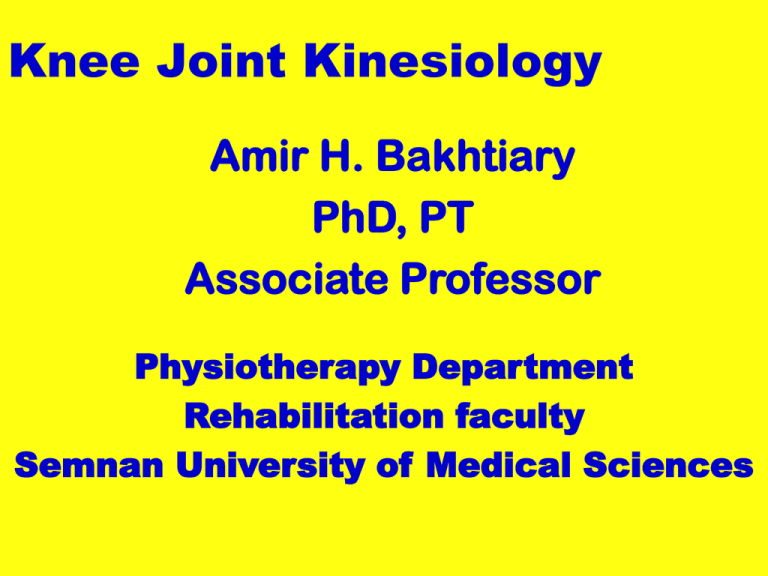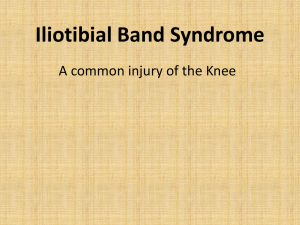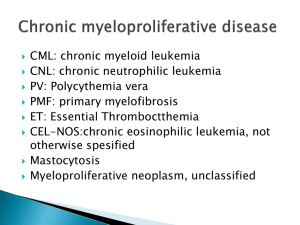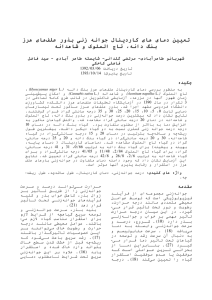Skeletal Abnormalities - Semnan University of Medical Sciences
advertisement

Knee Joint Kinesiology
Amir H. Bakhtiary
PhD, PT
Associate Professor
Physiotherapy Department
Rehabilitation faculty
Semnan University of Medical Sciences
Knee Extensors Muscles
Gluteus Max and
Soleus may help
knee Ext in Closed
Kinematic Chain
(Movements
Quadriceps
عضله چهارسر رانی
• تنها بخش دومفصلی آن رکتوس فموریس است
• جهت نیروی کشش آن نسبت به تنه فمور
• 10-7درجه به داخل و 3تا 5درجه به جلو
• جهت کشش 35 VLدرجه بطرف خارج
• جهت کشش VIموازی با تنه فمور
• جهت کشش VM
−الیاف فوقانی 18 – 15درجه بطرف داخل
−الیاف تحتانی یا مایل 55-50درجه بطرف داخل
• بخش VMدرانتهای دامنه Extزانو فعال می شود
Compress
force
نقش پاتال بر عملکرد عضله چهار سررانی را تعریف کنید؟
قرار گرفتن پاتال در داخل تاندون عضله چهار سررانی
• افزایش گشتاور نیروی عضله چهارسررانی از طریق
•
•
•
•
• افزایش MAتاندون چهار سررانی
• افزایش فاصله تاندون کوادریسپس و پاتال از محور حرکت زانو
تغییر جهت خط کشش عضله کوادریسپس
افزایش زاویه کشش تاندون
کاهش اصطکاک بین تاندون و سطح فمور
نقش ی بیشتر از یک قرقره ساده بازی کرده
• هم تغییر جهت نیرو
• هم تغییر اندازه نیرو
• برداشتن پاتال موجب کاهش نیروی کوادریسپس تا %49بدلیل کاهش MA
The role Of patella in
improving Quadriceps Torque
Anterior Translation Force
of Quadriceps
Increase the muscle force
by Knee Ext in OKC
Cause More tension on the ACL
Decease the muscle
force by Knee Ext in
OKC
Cause Less tension on the ACL
Quadriceps Weakness
Patellofemoral Joint
نقش پاتال در مفصل پاتلوفمورال مانند قرقره اکسنتریک آناتومی شامل )1تغییر جهت
نیرو )2 ،افزایش اثر نیرو و )3کاهش اصطکاک بین سطوح
• بستگی به قابلیت تحرک چهار گانه آن دارد
• ( Patellar Flexion/Extensionتحرک اصلی)
• ( Patellar Tiltاجازه تطبیق پاتال با کندیلهای نامتقارن فمور)
• ( Med Tiltبین 30-0الی 100درجه )Flex
• ( Lat Tiltبین 20الی 100درجه )Flex
• ( Med & Lat Rotationچرخش زاویه تحتانی پاتال به تبعیت از تیبیا)
• بین 25الی 100درجه Flexپاتال 7-6درجه به خارج می چرخد
• Medio-lateral Translationیا Patellar Shift
• :Activeدر انتهای 7/5 EXTتا mm 10جابجایی خارجی
• :Passive
( Full Ext −جابجایی داخلی ،9.6 mm :جابجایی خارجی)5.4 mm :
−در 35درجه ( Flexجابجایی داخلی ،9.4 mm :جابجایی خارجی)10 mm :
Open kinematics Chain
Patella
Movement
During
Knee
Flexion
Patella Movement
During Knee Flexion
Closed kinematics Chain
Patellar Tilting
Medial and Lateral rotation
Medial and Lateral Shift
Patellofemoral Joint Surface
سطح مفصلی پاتلوفمورال
• ناسازگارترین سطوح مفصلی بدن
• سطح مفصلی پاتال بسیار کوچکتر از فمور
• خصوصیات غضروفی ان از یک نقطه به نقطه دیگر متفاوت است
• سطح مفصلی پاتال توسط غضروف ضخیمی پوشیده شده
• توسط یک ستیغ مرکزی به دو بخش داخلی و خارجی تقسیم شده
• هر دو بخش صاف تا کمی محدب (در دو صفحه ساژیتال و فرونتال)
• در %30موارد فاست داخلی تری به نام Odd Facet
• سطح مفصلی فمور با یک شیار به دو بخش داخلی و خارجی
• در فرونتال مقعر و در ساژیتال محدب (فاست خارجی محدب تر)
• زاویه بین دو فاست ( 138°از 116تا 151 °بین افراد مختلف متغییر)
Patellar Joint Surface
Patellofemoral Joint
Surfaces
Patellofemoral Contact Surface
سطح تماس پاتال با فمور
• هیچ تماس ی در Full extوجود ندارد
• با افزایش Flexتماس سطوح افزایش یافته (از پایین به باال)
•
•
•
•
•
در 10تا 20درجه Flexاولین تماس با سطح تحتانی پاتال
در 45درجه flexنیمه میانی پاتال وارد تماس شده
در 90درجه flexتمام قسمتهای پاتال وارد تماس شده
با flexبیش از 90درجه پاتال وارد شیار بین کندیلی شده و Odd facetدر تماس
قرار گرفته
در 135درجه flexتماس فقط در فاست خارجی و Odd Facet
• فاست داخلی بیشترین تماس و odd Facetکمترین تماس را تجربه
• عدم تعادل در نیروهای وارده بر غضروف مفصلی منجر به تغییرات دژنراتیو در این فاستها می
گردد
Reaction Force on the
Patellofemoral Joint
نیروهای وارده روی مفصل پاتلو فمورال
• در Full extنیروهای کوادریسپس و پاتال یکدیگر را خنثی کرده
• پاتال در حالت تعادل در مقابل فمور قرار دارد
• با افزایش Flexبرآیند این دو نیرو موجب فشرده شدن پاتال روی فمور
• با افزایش Flexاین نیرو افزایش یافته
• موجب نیروی عکس العمل روی سطوح مفصلی گردیده که میزان آن تحت تاثیر
• Knee Flexion
• Quadriceps Force
• Elastic Passive Force
• اندازه نیروی عکس العمل
• راه رفتن عادی ( 10تا 15درجه Flexزانو) %50وزن بدن
• باال و پائین رفتن از پله ( 60تا 90درجه Flexزانو) 3.5برابر وزن بدن
• فعالیتهای همراه با Flexشدید زانو ( 135درجه )Flexتا 8برابر وزن بدن
Reaction force on
the patellofemoral
surface
Medial shift of Patella during Flexion
Mechanism of Lateral
force on the patella
What is the Compensatory Mechanisms for
Compressive Force Distribution in
patelofemoral joint?
• Contact area with knee flexion
• Medial facet contact from 30-70
•
Thickest hyaline cartilage in body
• Largest QF MA 30-70
•
QF torque as MA decreases
• QF tendon contacts condyles 70-90
What are the Medial and Lateral Stability
?factors of Patellofemoral Joint
ثبات طرفی مفصل PFتحت تاثیر متقابل دو مکانیسم قرار دارد
• مکانیسم عرض ی (رتیناکولوم اکستانسوری)
• مکانیسم طولی (تاندونهای پاتال و کوادریسپس)
• تعادل بین این دو مکانیسم منجر به حرکت صحیح پاتال هنگام حرکات زانو
میشود یا Patellar Tracking
• در صورت بر هم خوردن تعادل بین عوامل فوق حرکت پاتال روی فمور
دچار اختالل می گردد
Normal Patella
Tracking
Maintains maximum
congruence
Passive restraints
Active restraints
Abnormal Patella Tracking
↓ congruence
Stretches capsule & retinacula
↓ contact area
Lateral
Medial
Causes of Abnormal Tracking
Skeletal abnormalities
Strength imbalance in QF
Strength imbalance in fibrous tissues
Compensatory movements in knee due to
abnormal foot movement
Causes of Abnormal Tracking
Skeletal abnormalities
Strength imbalance in QF
Strength imbalance in fibrous tissues
Compensatory movements in knee due to
abnormal foot movement
Skeletal Abnormalities:
Q-angle
مقدار طبیعی = 10تا 15°
با Flexکاهش یافته
عوامل موثر بر افزایش آن
.1پهنتر بودن لگن
.2افزایش anteversionفمور
.3افزایش Valgusزانو
Increases in Q-angle are associated with:
femoral anteversion
external tibial torsion
laterally displaced tibial tubercle
genu valgus
Wide Hips (female runners)
Pronation of the feet
Subluxating Patella
High riding patella (Patella Alta)
Weak Vastus Medialis
Q Angle and contact
pressure
Skeletal Abnormalities:
Genu Varum & Genu Valgum
Q angle w/ age
Varum common in
very young children
Valgum seen in
growing children
Menisectomy effects
Skeletal Abnormalities:
Patella Alta & Patella Baja
Index of Insall & Salviti
LP/LT
Normal = 1.0
Patella alta = 0.8
Patella baja = 1.2
Women ratio
Skeletal Abnormalities:
Patella Surface Lateral Border
Appositional forces ↓ in full
extension
Prominence of lateral
border prevents lateral
displacement
Underdevelopment
common in children as
growing
Skeletal Abnormalities:
Femoral & Tibial Torsion
Lateral tracking
Causes of Abnormal Tracking
Skeletal abnormalities
Strength imbalance in QF
Strength imbalance in fibrous tissues
Compensatory movements in knee due to
abnormal foot movement
QF Strength Imbalance
Causes of Abnormal Tracking
Skeletal abnormalities
Strength imbalance in QF
Strength imbalance in fibrous tissues
Compensatory movements in knee due to
abnormal foot movement
Fibrous Tissue Strength
Imbalance
IT
Causes of Abnormal Tracking
Skeletal abnormalities
Strength imbalance in QF
Strength imbalance in fibrous tissues
Compensatory movements in knee due to
abnormal foot movement
Compensatory Movement
Pronation of foot accompanied by medial rotation of
tibia medial rotation & medial translation of patella
Pronation coupled w/ forceful quadriceps femoris
leads to anterior tilt
EX: jumping, landing, running
Knee pathology
Meniscal lesion
Meniscal lesion can also occur through a
collision and is thought deep knee bends can
also be a cause.
A transverse tear of the lateral meniscus
A transverse tear of the lateral
meniscus
A longitudinal tear of the lateral
cartilage meniscus
Damage to the medial
meniscus at it's attachment to
the ligament. Also shown a
longitudinal tear in the lateral
meniscus.
The cartilage gets squeezed
between the bones with most
of your bodyweight on top!
McMurray's click test for the integrity of the meniscus. This
test is done to "pinch" the menisci against the femur. Internal
rotation of the tibia on the femur stresses the posterior medial
and the anterior lateral menisci
McMurray's click test for the integrity of the meniscus. This
test is done to "pinch" the menisci against the femur. External
rotation stresses the anterior medial menisci and the posterior
horn of the lateral menisci.
Osteocartilage
degenerative changes
History of Injury
• Acceleration Mechanisms
• (lower leg slipping forwards)
• Deceleration Mechanisms
• (lower leg stops suddenly)
• Hyper Extension Mechanisms
• (Bad Tackle)
• Torque ('twisting') Mechanisms (jumping while
twisting, when the foot lands and grips the ground
surface, while the body continues the twisting
motion with the full weight of the person behind it.
ACL & PCL injury
Anterior Drawer Sign
The ACL ligament
is injured through
twisting the knee or
through an impact to
the side of the knee
- often the outside.
Posterior Drawer Sign
The posterior Cruciate ligament is injured through
hyperextension of the knee or bending it backwards.
Jumpers Knee
(Patellar tendinopathy - sometimes called
Patellar tendinitis)
Under extreme stresses such as those
involved in jumping a partial rupture
can occur. This can often lead to
inflammation and degeneration of
the tissue. Inflammation can also
result from overuse.
Patella Alta
Patella alta – the patella rides so high it loses the
passive stabilisation of the lateral condylar ridge.
Side to Side
Unstability
Collateral Ligaments
Injury
If the force from the injury is great enough, other
ligaments may also be torn. The most common
combination is a tear of the MCL and a tear of the
anterior cruciate ligament (ACL).











